I recently completed a review of a visual novel titled A Dream of Summer as part of my al|together visual novel translation review project. A Dream of Summer is the official 2006 translation of a 2005 freeware Japanese visual novel by milkcat called Hitonatsu no Yume. While it has distinct positive points, including strong production values for a freeware novel of the era, I had some issues with the script and story which held it back from the upper-echelon of al|together translations. There is, however, one area where its script arguably reigns supreme: Hair color descriptions.
(See my full collection of posts on hair color in Japanese anime, manga, novels, and games.)

Long time New Leaf Journal readers may have come across some of my articles on hair color in Japanese anime, manga, and visual novels. I explained in some detail in my first article of the series that I am interested in how to understand unusual hair colors in Japanese media.
Few of the al|together novels have tackled hair color head-on. One, Red Shift, inspired a lengthy article because it discussed in some detail the albinism of one of its two main characters. I did not come across any other al|together novels with hair color discussion worth writing home about (much less posting to The New Leaf Journal) until A Dream of Summer.
A Dream of Summer has a typical Japanese high school setting. Although there is discussion of ghosts, the students in this high school do not possess any special powers and none are aliens or anything of the like. Thus, when we are presented with characters who deviate from the Japanese norm of black hair, we should generally assume either that the hair color choices were either made for artistic purposes (e.g., to help distinguish the characters) or that the characters are, in fact, dying their hair. In the case of a freeware visual novel from the early 2000s, I would ordinarily assume that unusual hair colors represent stylistic choices. For example, prior to creating A Dream of Summer, the developer, milkcat, released a visual novel that was also translated for al|together 2006 titled At Summer’s End. The seemingly-noseless main female character in that game, a Japanese middle school student, had dark reddish-purple hair.

I never doubted that this was anything other than a stylistic choice.
But as we will see, A Dream of Summer throws a different set of hair color cards on the table within the first few scenes. In fact, A Dream of Summer makes its first hair color reference in a prologue scene before we even meet the primary view-point character,Toshiki!

However, Milk is a cat. There is nothing too unusual about a white cat. But this is technically the first hair color reference. The prologue scene is narrated by Mizuna Hazuki, whose hair we will address in due course.
Very brief prologue aside, we see almost all of the events in A Dream of Summer through the eyes of the principal protagonist, Toshiki Sugai. In the game’s second scene after the player takes Toshiki’s perspective, we meet his best friend, Reiji Nishihara.
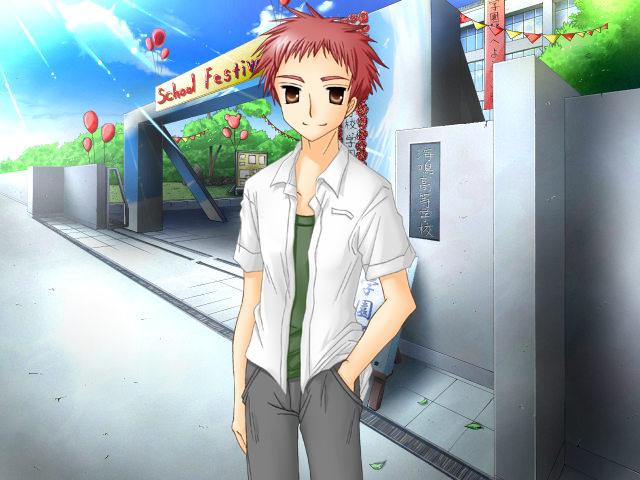
As you can see, Reiji has reddish hair. While there are plenty of natural redheads, very few of them are Japanese. When I first saw on Reiji, I assumed that, much like the main heroine of At Summer’s End, the creator chose to give him red hair for aesthetic reasons. However, I soon discovered that this was not the case. After one page of dialogue wherein Toshiki and Reiji exchanged pleasantries, we are treated to the internal monologue of Toshiki:

The color of his hair is red and is styled somewhat similarly to a purple sea urchin.
Toshiki (internal monologue)
Here, Toshiki makes a mental note that Reiji has red hair. Since Toshiki is our narrator, we can now be sure that Reiji does in fact have red hair in the game’s world. But what does this mean? In a previous hair review post, I wrote about learning that Futaba Igarashi, a Japanese character in an anime series with a real-world Japan setting, has naturally green hair. I concluded that we had to accept that in that anime version of Japan, natural green hair was a thing. I came to a similar conclusion about a girl who appears close to the start of MYTH, a very peculiar visual novel with some supernatural elements. Thus, while we know that Reiji does in fact have red hair, we do not know what that means in A Dream of Summer. Do Japanese people have naturally red hair here or is something else going on? Let us continue with Toshiki’s internal monologue:
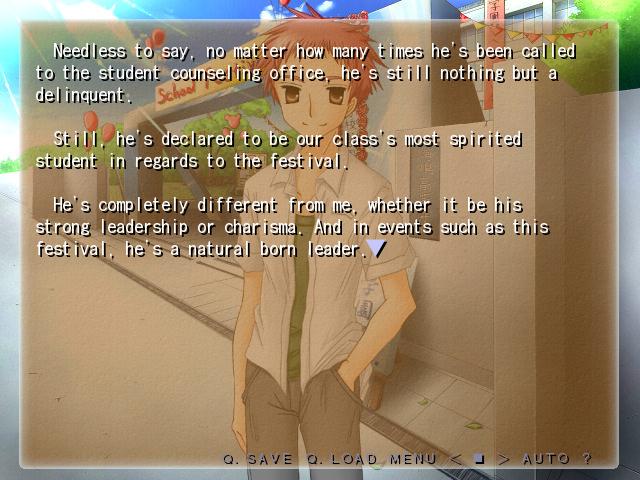
[N]o matter how many times he’s been called to the student counseling office, he’s still nothing but a delinquent.
Toshiki (internal monologue)
I took this line as evidence that Reiji is dying his hair and that part of the reason he is being called to the student counseling office is because of his dyed hair. While Toshiki portrays Reiji as a slacker, there is no evidence in the opening scene (or elsewhere) that Reiji is a delinquent in the sense of being a troublemaker. In fact, as you can see in the above screenshot, Toshiki praises Reiji for having a natural charisma and leading the class’s preparations for the cultural festival (Toshiki later admits in a conversation with Reiji he only showed up to school to help prepare because Reiji would have showed up at his house if he tried to stay home). Thus, between Toshiki’s making a point of noting Reiji’s hair color and style, stating that he had problems with the counseling office, but otherwise praising his character and initiative, I was left with the impression that his hair color and dress code violations were linked to the summons to the counseling office.
Here, we should note that my assessment is based on DejaVu’s English translation of the original Japanese novel. Thus, we need to unlock how the translation of Toshiki understands the word delinquent in this particular context. Toshiki’s direct interactions with Reiji did not resolve the question. However, a scene involving another character provided additional evidence to support my initial theory. Toshiki runs into two girls – Mami Kagawa and Rin Shinoi – after Reiji sends him to the vending machine to buy drinks.

Kagawa is on the left and Shinoi is on the right. Both girls are part of a four-person band called BROY with Reiji. In the novel itself, Kagawa is the least significant of the four characters with portraits whereas Shinoi has a full route. However, this article is about hair color rather than the novel’s story. Shinoi has what appears to the black hair. Kagawa, on the other hand, does not have black hair. Having been treated to Toshiki’s monologue about Reiji’s hair, your resident 2D Japanese person hair color anthropologist eagerly anticipated Toshiki’s next monologue. Our protagonist did not disappoint:

Light from outside shone through her brown, close to golden, hair and made it shine even more.
Toshiki (internal monologue)
I initially assumed Kagawa was bleach blonde, but Toshiki describes her hair as being “brown, close to golden.” There are obviously some character design limitations here, so we must accept that her hair is a very light brown inclined toward blonde.
As we saw with Reiji, Toshiki kept his hair analysis to himself. However, he broached the subject with Kagawa:
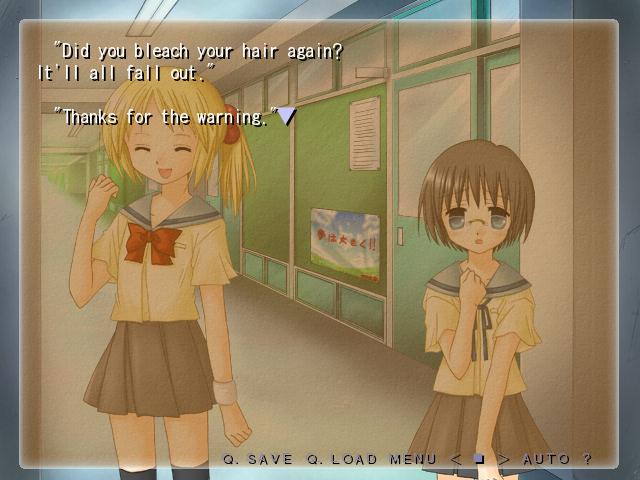
“Did you bleach your hair again? It’ll all fall out.”
Toshiki
Kagawa responded sarcastically:
Thanks for the warning.
Kagawa
This scene unlocks the mystery of hair color in A Dream of Summer. Toshiki’s question, “did you bleach your hair again” presupposes that she has been bleaching her hair in the past. Kagawa implicitly acknowledges that she bleached her hair to change her hair color. This scene establishes clearly and beyond doubt that unnatural hair colors are not natural in the world of A Dream of Summer like they were in Futaba’s My Senpai is Annoying. Hair dye exists and explains unnatural hair colors. From this interaction with Kagawa, we can assume with near certainty that Reiji is dying his hair.
The next scene sheds more light on Kagawa’s hair:
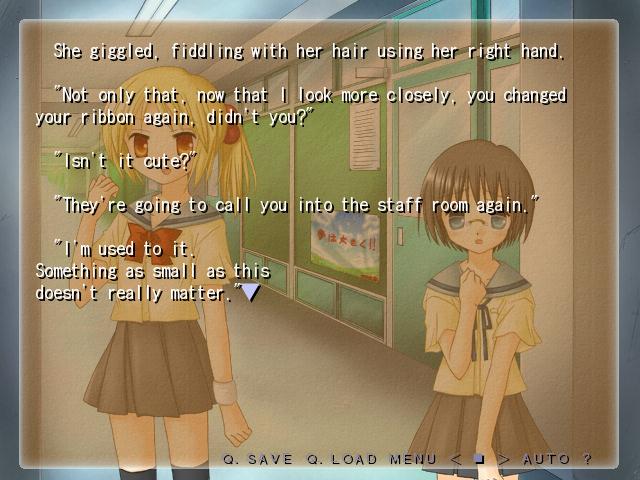
To begin, we see that Kagawa did not mind Toshiki’s warning about her hair falling out. She takes Reiji’s commentary in stride. The subject shifts from hair color to hair style, and Toshiki warns Kagawa that she is going to be called to the staff room again. This too is big. Toshiki is very clearly tying Kagawa’s hair color and style to her being called to the staff room.
Next line:

This delinquent of a girl is Kagawa Mami.
Toshiki (internal monologue)
This scene, in conjunction with the initial monologue about Reiji, further supports how the word “delinquent” is being used in this translation. The only evidence we have that Kagawa is a delinquent pertains to her hair color and accessories. The only reason that Toshiki offered for her being called to the staff room relates to her hair. I think that Toshiki used the term delinquent in the same sense with Reiji. Moreover, this supports that Toshiki’s referral to Reiji as a delinquent and noting his trials with school counseling office were directly related to his hair.
Before continuing to the next hair case, let us look at a fun note about BROY, the band in which Reiji, Kagawa, and Shinoi are members:
![Kagawa explains the meaning of the band name BROY in "A Dream of Summer": "[BROY] stands for ‘Between Red or Yellow’. If you see the first letter of each word, you get BROY. Our concept is that people should have their eyes on our musicianship as if we were a red-yellow danger signal."](https://thenewleafjournal.com/wp-content/uploads/2023/10/broy-band-name.jpg)
[BROY] stands for ‘Between Red or Yellow’. If you see the first letter of each word, you get BROY. Our concept is that people should have their eyes on our musicianship as if we were a red-yellow danger signal.
Mami Kagawa
This is one area where translation nuances could affect the original reading. But with my only being able to read the English version (the Japanese version is available to download or play online for free, but I cannot read Japanese), I could not help but notice that the name seems to also match the hair colors of Kagawa and Reiji with the caveat that while Kagawa’s hair is colored yellow and looks blonde, Reiji noted that he observes it as being light brown and almost blonde.
(Toshiki has no commentary on Shinoi’s hair other than that it is short. Based on her design and characterization, I assume Shinoi has black hair.)
Finally, we meet Mizuna, the more significant of the two girls who have routes (Shinoi has the other route).
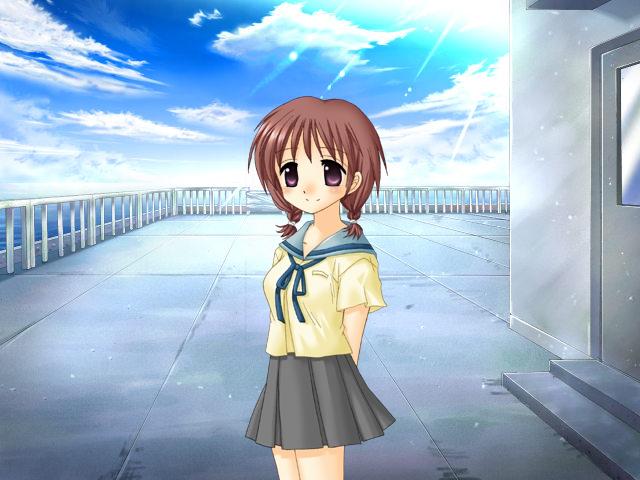
Mizuna appears to have dark brown hair. Toshiki never references Mizuna’s hair color in the text of the visual novel. Thus, we are left with two possibilities:
- Mizuna actually has brown hair; or
- Mizuna’s hair is dark enough that it would not cause anyone to make note of it.
From the outset, nothing about Mizuna’s characterization suggests she would be dye her hair in defiance of school regulations. I generally assume that her hair is intended to be dark enough that it would not cause Toshiki to make a note the color. We have evidence in the case of Kagawa that what Toshiki observes a character’s hair color being may differ somewhat from how we would immediately understand the hair color based on the character portraits. From an aesthetic standpoint, it is worth noting that Mizuna is used on the novel’s cover and all of its promotional materials, so more thought likely went into her design than any of the other characters. I have covered at least one case wherein Kaori Orimoto, a character in the novels My Youth Romantic Comedy Is Wrong, As I Expected, is depicted in the corresponding anime series as having dark brown hair whereas she is explicitly described in the novels as having black hair.
While I think that Mizuna in the game’s world has a hair color that would not cause anyone in a Japanese school to think twice, we cannot entirely rule out the possibility that she has naturally brown hair. My first hair color article in the series focused on the case of Iroha Isshiki in the My Youth Romantic Comedy Is Wrong, as I Expected novels (the hair point does not come up in the anime adaptation). By the time Iroha appears, it has been well established that many of the characters dye their hair and ignore the uniform dress code. Iroha is fashion-conscious and has brown hair, so one may naturally assume she too dyes her hair. However, the protagonist notes to himself in an internal monologue that Iroha appears to be a natural brunette based on her visible roots. Her natural brown hair does not otherwise receive commentary. I published a longer article on an anime called Ippon! Again in which one of the characters, Anna Negumo, has naturally brown hair. Other than being hassled by a teacher who mistakenly believes she is dying her hair in one scene, no one else comments (note that the Ippon! Again article was the only article in the series prior to this one that addressed hair color and school discipline). Conversely, there was another character in Ippon! Again with brown hair. In that case, the main characters immediately and correctly identified her hair as being dyed. These cases suggest that we cannot rule out the possibility that Mizuna does actually have dark brown hair instead of black hair and that most people around her would recognize that as being her natural hair color.
While one technical point about Mizuna’s hair color will have to remain unresolved, we do have plenty to talk about regarding her hair. Note that while most of the articles in this series are about hair color, I explicitly included hair styles in the ambit of the series thanks in part to an anecdote piece I published. While Toshiki does not comment on Mizuna’s hair color, he does have plenty of commentary on her hair style:
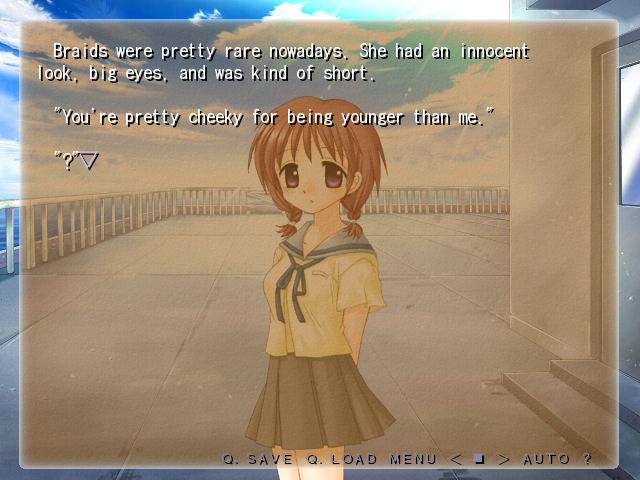
Braids were pretty rare nowadays.
Toshiki (internal monologue)
Toshiki notes Mizuna’s braids before anything else about her appearance. By “pretty rare,” I understood Toshiki as suggesting that braids were uncommon for high school girls. Toshiki segued into pondering other aspects of Mizuna’s figure, but we will meet him again once he gets his mind out of the gutter.

Here, Toshiki again comments on Mizuna’s braids, describing them as fluttering in the sea breeze. Toshiki then verbalizes his internal musings, much to Mizuna’s chagrin:
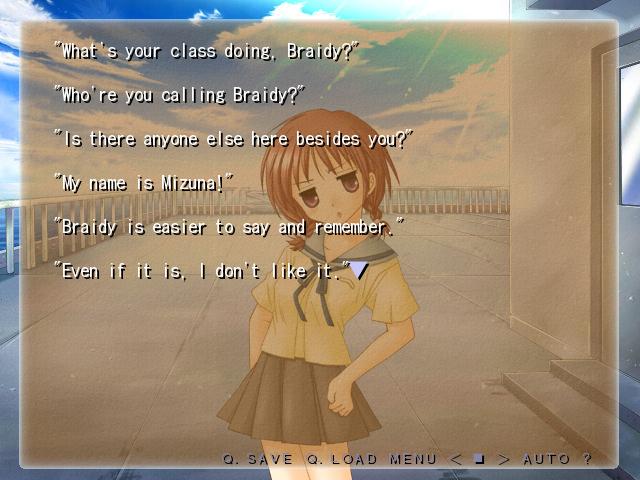
What’s your class doing, Braidy?
Toshiki
Toshiki opts to call Mizuna “Braidy” despite the fact that she had told him her name in the same conversation (I did not include that screenshot here). I would post all of the instances of Braidy, but that would be difficult since the novel is fairly long and Toshiki calls Mizuna Braidy in most of their interactions. For her part, Mizuna gives up and accepts her fate:
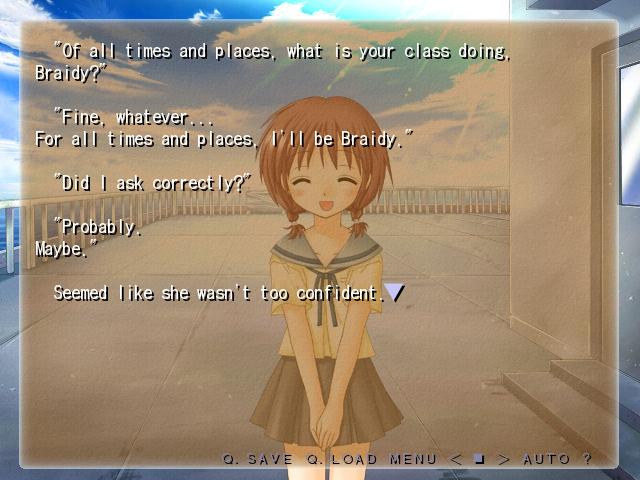
In my review of the novel itself, I faulted the writing for making Toshiki unnecessarily abrasive toward Mizuna. His immediately calling her Braidy after having just met her on the roof and despite the fact that she was pleasant toward him was one of the events underlying my analysis. Due to the sheer volume of Brady references, listing them all would require me to include screen-shots of a good portion of the novel. But I will include a few additional references to highlight Toshiki’s long-term obsession with Mizuna’s braids:

In this scene, Shinoi is but a mere bystander as Toshiki antagonizes Mizuna, who, despite having accepted her fate as Braidy, brings up the issue that I have with Toshiki’s behavior. One reason Toshiki’s commentary on Kagawa’s hair comes off differently is because it is clear that Toshiki and Kagawa had already known each other well and had a good rapport (not to mention Toshiki is likely correct that Kagawa is flagrantly violating the school dress code and Kagawa is aware of this). With Mizuna, however, upon first meeting her he jumps straight into commentary on her braids, which, while arguably a childish hair-style, are a far cry from bleaching one’s hair.
Toshiki, having assigned a nickname to Mizuna because he thought her braids were childish, would later do the most mature thing possible:

Pull her braids! The sad thing is that Toshiki is probably unaware that he is behaving like an elementary school boy with a crush. Now, it would have actually been possible for the novel to do something smart with my description of Toshiki’s given one of the central points of Toshiki’s story is his fixation on a promise he made with a girl when he was a kid (beyond the scope of this article), but the novel sadly passed on the opportunity to do so.
Toshiki would later assign super powers to Mizuna’s braids:
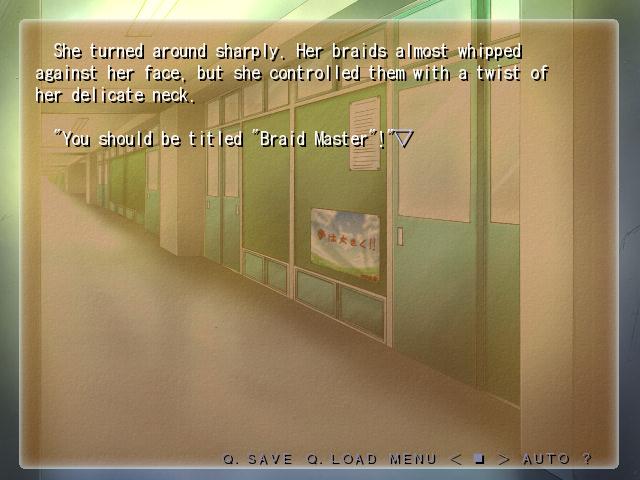
Mizuna’s braids appear to be short, so I doubt that she could take out one of Toshiki’s eyes. I am on Mizuna’s side, but Toshiki continued to insist:
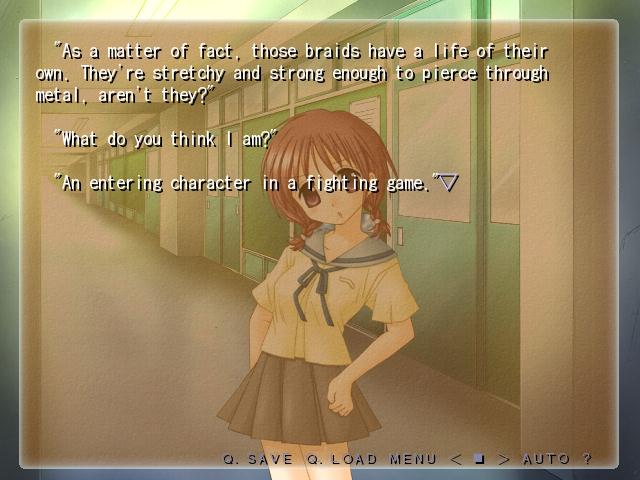
In this scene, Mizuna makes a small effort to stand up to Toshiki’s obsession:
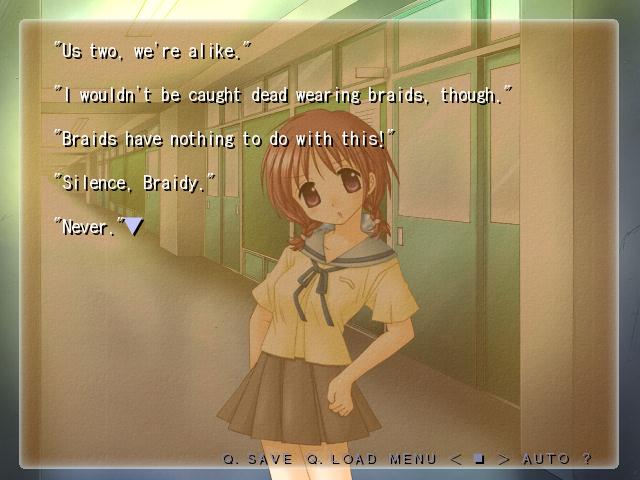
I will note that some of the braid jokes could differ in the English version from the Japanese version. However, regardless of the specific points of the translation, I assume that that in the original Japanese novel, Toshiki fixates on what he considers to be Mizuna’s childish hair style and he gives her a nickname based on it.
There is one character whose hair we have not addressed: Toshiki himself. We have already seen the only characters with portraits. However, while Toshiki does not have a regular portrait, he is depicted in several CG scenes. I cannot show any of the CG scenes featuring Toshiki in full without spoiling the story – and in light of the fact that this is a free visual novel worth a look (despite its faults) – I would prefer not to include unnecessary spoilers. Thus, I will feature cropped versions of the CG scenes in question showing Toshiki’s hair:
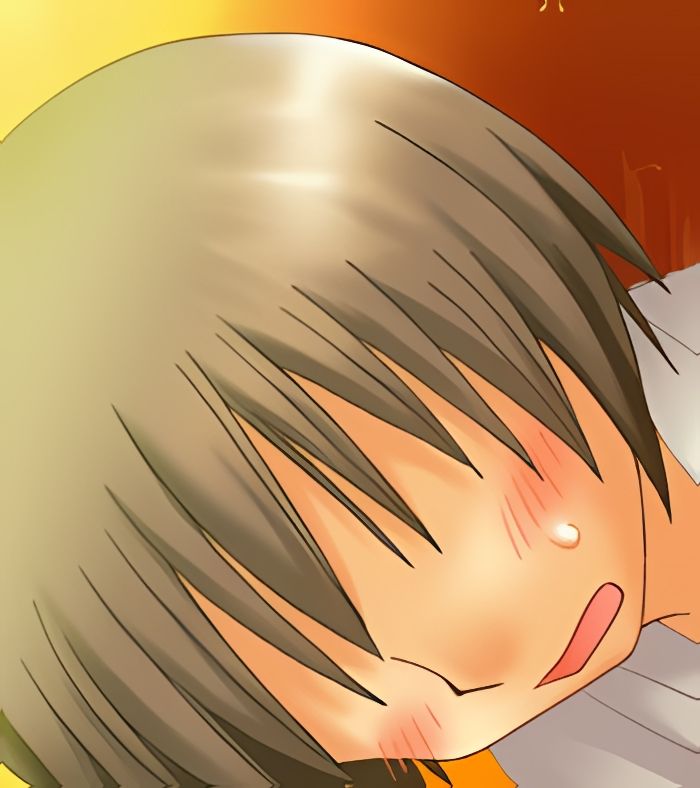

(Note: I upscaled both Toshiki images since they would have been very small otherwise. I do not think that the upscaling meaningfully affected the color.)
Toshiki’s hair in the first image is a similar sort of dark gray to Shinoi’s, although there is a distinct hint of brown. The second image looks a bit more brown, but it is colored by the sunset (A Dream of Summer has a focus on lighting). For the record , in at least one CG with Toshiki and Mizuna, Mizuna’s hair is clearly distinguishable from Toshiki’s in being much more brown. Toshiki’s hair looks more similar to Shinoi’s in at least one of their CG scenes. Based on Toshiki’s commentary about Reiji and Kagawa, I assumed he had natural, un-dyed hair. Nothing about his two CG scene appearances changes my assumption.
A Dream of Summer joins Red Shift as being the only al|together-translated visual novel to tackle hair color in a meaningful way. With respect to my series on hair color, A Dream of Summer’s hair color scenes fit in more neatly because the series was initially inspired in large part by real-world stories about Japanese students with naturally brown hair. While I had issues with A Dream of Summer’s script to the extent that I think it failed to fully realize the potential of its set-up and strong production values, I appreciated that the early hair color scenes gave us enough information to understand one of the most prominent aspects of the character designs. Moreover, it tied Reiji’s and Kagawa’s hair style choices to their characters, making clear that they were willing to dye and style their hair how they wanted even if it meant having difficulties with the school administration, and further tying their carefree attitudes into their interest in being in a bad.
Well done.